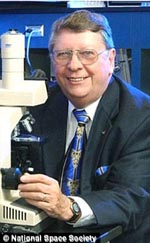By Jason McClellan | OpenMinds
 Astrobiologist
Richard Hoover spent more than forty six years working at NASA. In that
time, he established the Astrobiology Research Group at the
NASA/Marshall Space Flight Center, and became internationally known for
his research on microfossils in meteorites. Hoover has published many
papers in which he asserts the discovery of extraterrestrial life in
meteorites.
Astrobiologist
Richard Hoover spent more than forty six years working at NASA. In that
time, he established the Astrobiology Research Group at the
NASA/Marshall Space Flight Center, and became internationally known for
his research on microfossils in meteorites. Hoover has published many
papers in which he asserts the discovery of extraterrestrial life in
meteorites. Hoover no longer works for NASA, but he continues his controversial research and is currently an astrobiologist at Athens State University and a visiting research professor with the Centre for Astrobiology at the University of Buckingham. Hoover discussed his research in a lecture at the 2014 International UFO Congress. At the event, Hoover sat down with journalist Lee Speigel of the Huffington Post. Speigel asked Hoover to explain what it is that convinces him that life is not restricted to Earth. Hoover responded, “I am absolutely convinced that life is not restricted to the planet Earth because I have found the remains of lifeforms that are absolutely, conclusively extraterrestrial.”
Speigel pointed out that Hoover’s findings have met with harsh skepticism by critics. But Hoover stands behind his research. He replied, “These critics will not debate me in an open scientific forum. I would be perfectly willing to go to the Cosmos Club in Washington, to go to any university and have an academic debate and scientific discussion.”
During Speigel’s interview, he also asked Hoover about a possible organism photographed by NASA’s Opportunity rover. Hoover explained,
Opportunity rover in 2004 took an image of a fascinating structure on Mars that shows structural features that are consistent with organisms on Earth known as crinoids . . . Crinoids are echinoderms, like starfish . . . so these are animals! And I’m saying that Opportunity took a photograph on Mars that shows features that are consistent with what we know of crinoids . . . Now, the fascinating thing is here you have a possible fossil of a very interesting organism in a rock on Mars, and three hours and a half after that photograph was done, that rock was destroyed by the rock abrasion tool.
[...]
Read the full article at: openminds.tv